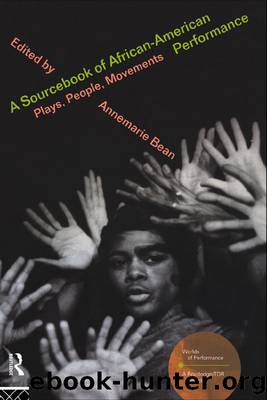A Sourcebook on African-American Performance by Bean Annemarie

Author:Bean, Annemarie.
Language: eng
Format: epub
Tags: ebook
Publisher: Taylor & Francis (CAM)
Published: 2011-08-17T16:00:00+00:00
NOTES
1. The American Baptist Home Mission Society supported Virginia Union University, Shaw University, Benedict College, Arkansas A&M, and Normal College at Pine Bluff, Arkansas. The Methodist Episcopal Church established the Centenary Biblical Institute (Morgan College), Shaw University in Holly Springs, Mississippi, and Rust College. The United Methodist Church established Bennett College. The Presbyterians established the Scotia Seminary [Barber-Scotia College, Biddle University, Stillman Seminary, Johnson C.Smith University]. The Episcopal Church established St Paul's Normal and Industrial Institute and St Augustine's College, among others.
2. For a personal account of the freedman's passion for education, read Booker T.Washington's autobiography Up from Slavery (1901). To appreciate the conflict generated by the internalization of English literary values over Black folk values, read Adrienne Kennedy's Funnyhouse of a Negro (1964) and The Owl Answers (1964).
3. For an authentic rendering of Black college life in the early part of the century, read Thomas D.Pawley's play, The Tumult and the Shouting (1969), in Black Theatre U.S.A. (1974). The classic portrait of a Black college administrator is found in Ralph Ellison's Invisible Man (1952).
4. See Cotter 1909.
5. Harrison founded his own Dramatic School at A&T [Agricultural & Technical] State University, Greensboro, North Carolina (1922–9).
6. Many African Americans did not want dialect recognized as acceptable speech. After William Dean Howell, the literary lion of New England, had blessed Dunbar's use of dialect in poems, they became quaint and acceptable for reading on college stages.
7. As late as 1916, there were only 67 Negro public high schools and these had fewer than 20,000 students in total; and 85 per cent of southern Negro students were enrolled in the first four grades (normally for ages 6–10). To remedy the problem, major philanthropy came from the George Peabody Fund (1867) which gave the first million dollars; the John F. Slater Fund (1882) gave another million dollars to church and private institutions; the Anna T.Jeanes Fund (1905) provided teachers and supervisors of teachers with salaries; the General Education Board (Rockefeller, 1902) gave $315 million, much of it scholarships for Blacks who would go south to teach; and the Julius Rosenwald Foundation built over 5,000 rural schools and gave teachers advanced training.
8. Locke 1922.
9. Among the recipients of General Education Board scholarships were Warner Lawson (music); Katherine Dunham (dance); Lois Mailou Jones (painting); and Anne Margaret Cooke, Owen Dodson, and James W. Butcher (theatre).
10. The members of SADSA included Florida A&M [Agricultural and Mechanical], Alabama State, Alcorn A&M, Lane College, LeMoyne-Owen College, Morehouse College, Morris Brown College, Prairie View A&M, Shorter, Spelman College, Talladega College, Tougaloo College, Southern University, Wiley College, Dillard University, Winston-Salem State Teachers, Atlanta University, Fisk University, and Tuskegee. These were later joined by Bethune-Cookman, Leland, Paine, Texas College, Bennett, Grambling, Tennessee A&I [Agricultural and Industrial], Lincoln University of Missouri, Langston University, Kentucky State College, Arkansas AM&N [Agricultural, Mechanical and Normal], and Xavier University. In 1997, there were 37 schools which listed themselves on the Internet as “Historically Black Colleges”.
11. The three regional divisions of SADSA were the Southwestern, the South, and the Southeastern.
Download
This site does not store any files on its server. We only index and link to content provided by other sites. Please contact the content providers to delete copyright contents if any and email us, we'll remove relevant links or contents immediately.
| African-American Studies | Asian American Studies |
| Disabled | Ethnic Studies |
| Hispanic American Studies | LGBT |
| Minority Studies | Native American Studies |
Cecilia; Or, Memoirs of an Heiress — Volume 1 by Fanny Burney(32434)
Cecilia; Or, Memoirs of an Heiress — Volume 2 by Fanny Burney(31871)
Cecilia; Or, Memoirs of an Heiress — Volume 3 by Fanny Burney(31852)
The Great Music City by Andrea Baker(31348)
We're Going to Need More Wine by Gabrielle Union(18967)
All the Missing Girls by Megan Miranda(15565)
Pimp by Iceberg Slim(14393)
Bombshells: Glamour Girls of a Lifetime by Sullivan Steve(13972)
Talking to Strangers by Malcolm Gladwell(13222)
Norse Mythology by Gaiman Neil(13204)
Fifty Shades Freed by E L James(13157)
For the Love of Europe by Rick Steves(12977)
Mindhunter: Inside the FBI's Elite Serial Crime Unit by John E. Douglas & Mark Olshaker(9200)
Crazy Rich Asians by Kevin Kwan(9167)
The Lost Art of Listening by Michael P. Nichols(7406)
Enlightenment Now: The Case for Reason, Science, Humanism, and Progress by Steven Pinker(7228)
The Four Agreements by Don Miguel Ruiz(6630)
Bad Blood by John Carreyrou(6552)
Weapons of Math Destruction by Cathy O'Neil(6143)
